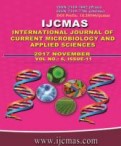


 National Academy of Agricultural Sciences (NAAS)
National Academy of Agricultural Sciences (NAAS)

|
PRINT ISSN : 2319-7692
Online ISSN : 2319-7706 Issues : 12 per year Publisher : Excellent Publishers Email : editorijcmas@gmail.com / submit@ijcmas.com Editor-in-chief: Dr.M.Prakash Index Copernicus ICV 2018: 95.39 NAAS RATING 2020: 5.38 |
Orofacial space infections are among the most commonly encountered problems in dental practice. Spreading odontogenic infections are the most common type of serious oral and maxillofacial infections and range from the periapical abscess to superficial and deep neck abscess. The purpose of this study was to identify and perform antibiotic susceptibility pattern of aerobes and anaerobes isolates from oral and maxillofacial infections. Fifty patients with space infection of odontogenic origin were selected irrespective of their age and gender. Pus samples were collected and processed in the microbiology laboratory for the growth of anaerobic and aerobic bacteria and antibiotic sensitivity profile. Demographic profile of the patients showed that male patients were more commonly involved and most patients fell into the third and fourth decade of age groups. Submandibular space was most commonly involved in 46% followed by buccal space in 20% cases. Staphylococcus aureus was the frequent aerobic bacterial isolate and among anaerobes, Peptostreptococcus spp. was most common 19(44%) followed by Porphyromonas gingivalis 7(16.27%). Clindamycin, Gentamycin, Linezolid, Imipenem were the most effective antibiotics. 20 % of the aerobes were resistant to penicillin. There is the predominance of Gram positive bacteria and sensitivity patterns were almost the same reflecting the relevance of ciprofloxacin, ceftazidime and amoxiclav in the treatment of maxillofacial infections. Metronidazole and clindamycin are effective antibiotic to treat anaerobic infection and should be given in combination to cover aerobic bacteria.
 |
 |
 |
 |
 |